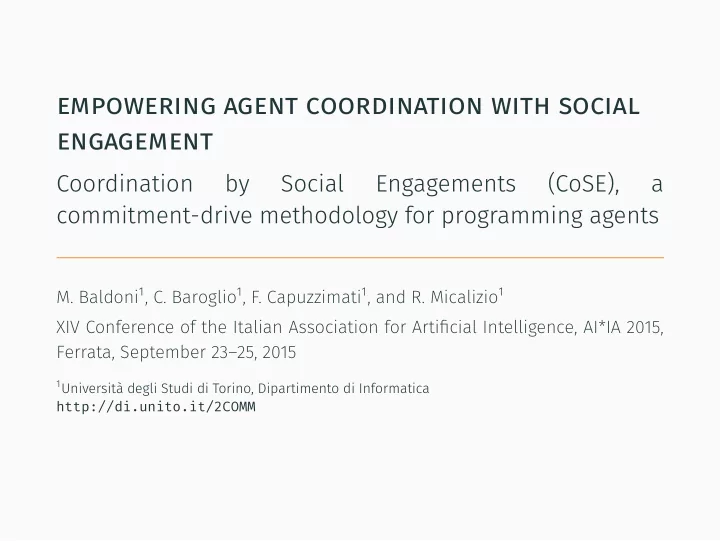

Coordination by Social Engagements (CoSE), a commitment-drive methodology for programming agents M. Baldoni 1 , C. Baroglio 1 , F. Capuzzimati 1 , and R. Micalizio 1 XIV Conference of the Italian Association for Artificial Intelligence, AI*IA 2015, Ferrata, September 23–25, 2015 1 Università degli Studi di Torino, Dipartimento di Informatica http://di.unito.it/2COMM empowering agent coordination with social engagement
CoSE allows implementing agents incrementally, one goal at a time, and by focusing on subproblems (i.e., behaviors), that either directly or via interaction will be programmed to obtain the goal at hand CoSE enjoys the following properties: 1 CoSE: Coordination by Social Engagements ∙ Agent-to-Agent Decoupling ∙ Agent-Logic-to-Coordination-Logic Decoupling Advantages: code verification , code maintainability
take into acount other agents, in their deliberative cycle 2 Rationale ∙ Programming of interacting agents : systematically approached based on the explicit representation of social engagements ∙ Basic idea : when agents can directly handle social engagements as resources , the coding phase can be organized in a precise sequence of steps ∙ Social engagements are captured as social commitments ∙ Advantages : ∙ software engineering perspective: decoupling , modularity of code ∙ modeling perspective: based on truly social dependencies, agents can
events (signs or signals), that are “physically” executed by the commitments agents 3 Social engagements ∙ CoSE extends environments by realizing Engeström’s activity systems ∙ Engeström’s objectified meanings are supplied by reified ∙ All interactions are driven by such meanings instead than by the
between any two agents that interact agents and the conditions the latter committed to have achieved 4 Social engagements ∙ Structures that explicitly represent the dependencies existing ∙ They can be used by agents in their practical reasoning together with beliefs , intentions , and goals for taking into account other ∙ They are implemented as observable properties of artifacts
5 Interactions extension of JaCaMo. ∙ Widly recognized that MAS design Interactions Organizations Environment ∙ JaCaMo integrates three parts: Agents MAS (Moise) Agents, Environment, Organizations, Interactions ∙ CoSE is rooted on JaCaMo+ , an and development involves: Agents , Environment , Interactions , and Organizations Agents (Jason), Environment (CArtAgO), and Organizations ∙ JaCaMo+ integrates also
programmed to react to signals. The plans that implement the only implicit agents are programmed to react to social engagements in order to achieve their conditions. The goal of the plan is the commitiment condition 6 JaCaMo+ ∙ In JaCaMo observational properties are signals and the agent is reaction are causally tied to such signals but such a relation is ∙ In JaCaMo+ observational properties are social engagements and
Social engagements (instead of signals) enable the specification of introduce a separation of concerns (Agent-Logic-to-Coordination-Logic Decoupling), so they enable the 7 JaCaMo+ CoSE because they make causal relationships explicit , they specification of standardized programming building blocks
8 . . . } 7 . . . 6 createCommitment ( c ) ; 5 4 3 @OPERATION { 2 @OPERATION 1 22 < 1 context 8 9 19 3 C-to-G: creditor C-to-G: debtor G-to-C goal plans social state interaction rules . . . 4 . . . { 2 1 . . . 12 } 11 . . . 10 20 21 18 ?q . 9 8 10 11 f < p < 7 6 12 ? r ; 13 social_action ; 5 f a i l u r e 14 4 15 /* plan to achieve 16 3 ? r ; context 17 2 < p < /* plan to handle CoSE uses programming building blocks Jason agent program Commitment artifact + ! G : − condition s */ ⟨ body ⟩ public void op1 ( . . . ) Commitment c = new Commitment ( . . . ) ; − ! G : − condition f */ ⟨ body ⟩ . + ! G : − public void op2 ( . . . ) ? cc ( x , y , s , u , CONDITIONAL ) . + cc ( x , y , s , u , DETACHED ) : cc ( x , y , s , u , CONDITIONAL ) − ! G 1 ; ? cc ( x , y , s , u , SATISFIED ) . cc ( y , x , s ′ , t , CONDITIONAL ) + cc ( y , x , s ′ , t , CONDITIONAL ) : − ! G 2 ; ? cc ( y , x , s ′ , t , DETACHED ) .
9 Questions? Please, come to our table! Session 1A, Council Room (G–1F)
Recommend
More recommend